A handy index to my “Franken-fruit” series.
If you squint, a lot of places that people live in are deserts. And if they’re not deserts, they’re semi-deserts.
What do I mean by a (semi-)desert?
A desert is a region of land that is very dry because it receives low amounts of precipitation (usually in the form of rain, but it may be snow, mist or fog), often has little coverage by plants, and in which streams dry up unless they are supplied by water from outside the area. Deserts generally receive less than 250 mm (10 in) of precipitation each year. Semi-deserts are regions which receive between 250 and 500 mm (10 and 20 in).
In the coming decades of tragic climate change, you can be sure that more and more inhabited regions will flirt with this definition.
I guess we could import water from nearby regions to irrigate once verdant lands, but doesn’t that strike you as a chef making do one with less lid than they have pots?
Another option is to sorrowfully embrace the drying lands by growing crops that have evolved to deal with these parched conditions.
That’s right; cactus.
Spiky Abundance
Nearly all cacti (Cactaceae family) have edible fruit, and the evidence for their consumption have been found as far back as 12,000 - 9,000 years ago in ancient Mexican and Peruvian landfills.
Perhaps the most commonly consumed cactus fruit is that of the Indian fig cactus, Opuntia ficus-indica.
The Indian fig cactus is also known as the prickly pear. It’s a case of a particular species in a genus being so famous that it basically lends its name to the genus. I’ll refer to O. ficus-indica as the Indian fig cactus to not muddy the waters from here on out, even though their wild ancestors are probably in central Mexico.
There’s lots of things going for O. ficus-indica. They can tolerate as little as 200 mm of annual rainfall, and can tolerate a shockingly huge temperate range (10°F to 122°F+, -12°C to 50°C+). In ideal conditions, they can grow up to 5 metres.
Let’s not forget their edible properties, which really sets them apart. The “pads”, when sliced and fried, have the texture and taste of green beans. The fruits have a delicious strawberry-watermelon flavour. Of course, like almost anything with a measurable amount of sugar, they can be fermented to produce alcoholic beverages.
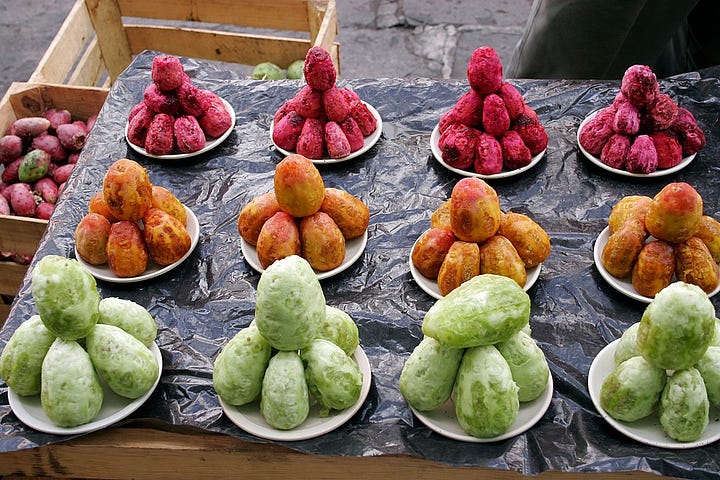
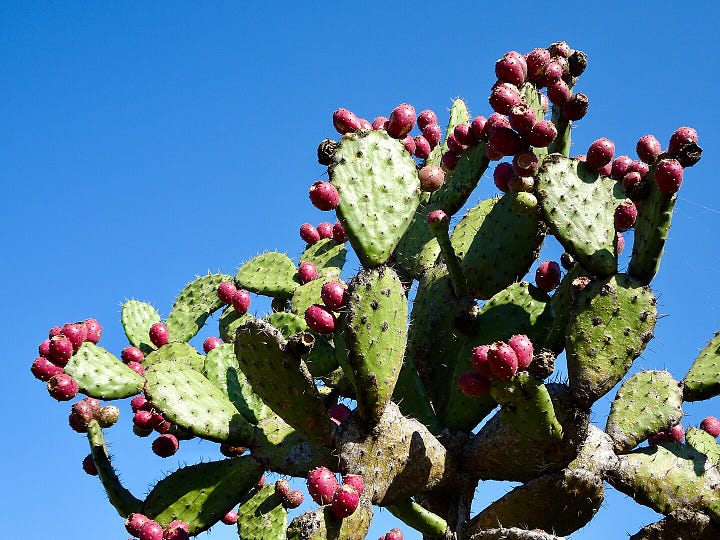
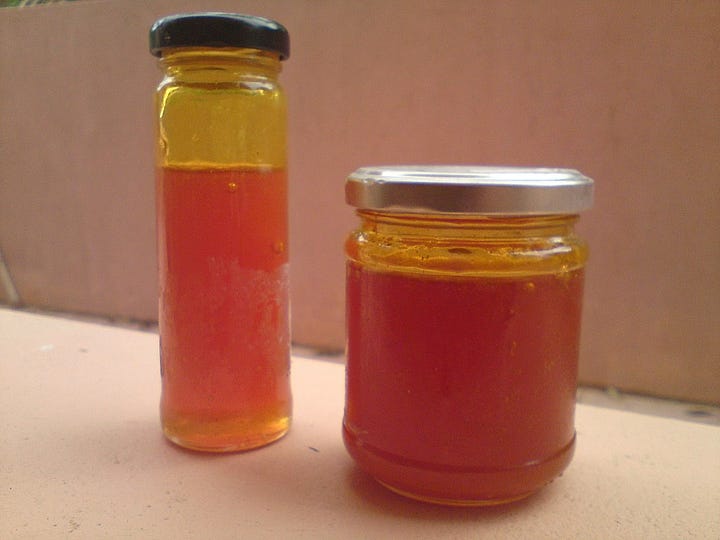
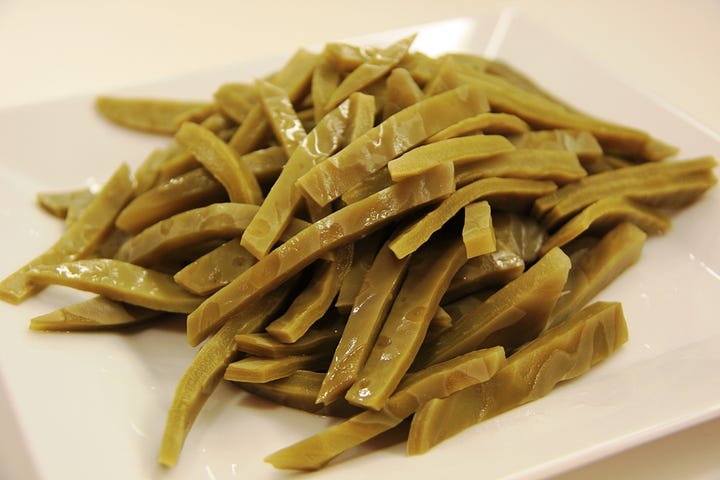
The famous plant breeder extraordinaire, Luther Burbank, became so fixated on Opuntia as a method to feed cattle in arid regions that he devoted a large part of life to breeding prickly pears that had no spikes or glochids.
And that’s the rub, literally! Like most cactus, the prickly pears have evolved various defenses to protect their precious stored water from browsing. Prickly pears share the stereotypical spines of pop-culture cactus. These spines, like all cactus, grow from structures known as areoles which are actually highly specialised branches. The spines themselves are vestigial leaves that lack chlorophyll but draw plenty of blood instead (not in a carnivorous way!).
For some reason lost to deep time, the subfamily to which prickly pears belong (Opuntioideae) are unique among the cactus to have evolved to grow prickly, barbed micro-hairs from their areoles too. These can be pretty nasty; they detach easily - even in a stiff breeze in some circumstances so don’t stand down wind - and are inconspicuous too. You definitely don’t want to get a mouthful, or even worse and eyeful, of the stuff. To add insult to injury, the glochids appear on the fruit too and can transfer between individuals using clothing as a carrier.
What a nightmare!
There’s plenty of thorny problems to overcome, but the threat of looming climate change and sporadic bursts of eco-responsibility have given the prickly pear an increasing spotlight over the years. If you have a search yourself, you’ll find it being grown for biofuel, soil erosion prevention, fodder for ruminants, medical research, and probably more.
As I alluded to in the introduction, I am interested in prickly pears from a food forest stand point. That is to say: how can we introduce Opuntia into a food forest setting without causing dermatitis, eye injuries and more from the spines and glochids? It’s a real concern; food forests are also food for the soul, and places to play with our loved ones.
We might give up already, because there’s plenty of edible perennials out there, but I believe Opuntia is a species that fits into a wonderful niche that few others occupy. It won’t have escaped your attention that extreme weather is on the rise; short periods of high rainfall and prolonged drought-like conditions.
This lumpy weather could play right into the Opuntia play book. My first suggestion, setting aside spikes for now, is to use any rubble on hand, and together with some soil, create a raised bed in a south facing, sunny spot. It’s really important that prickly pears do not have wet roots.
So if you don’t care about glochids and spikes, you can stop reading now. Instead of irrigating your fruit trees, grow stands of Indian fig cactus. Job done. It’s wild, really. Instead of the cactus “pushing the zone”, the traditional fruit trees such as apples are being squeezed from the other side.
For those who care about flying, spiky hairs, let’s continue.
Shaving the Prickles
In the previous section, we spoke about Luther Burbank devoting his life to growing prickle-free Opuntia. His vision was of vast swathes of safe Opuntia which could be sustainably harvested to feed cattle, thereby meaning cows could be moved from prime agricultural lands to more arid expanses.
Unfortunately, he did not succeed.
Burbank set about crossing different Opuntia together and releasing some spineless varieties. It was found that his smooth cultivars would regenerate their spines if stressed from extreme heat and water scarcity. Imagine devoting 20 years of your life to taming this species, only to have it reassert its primitive wilderness.
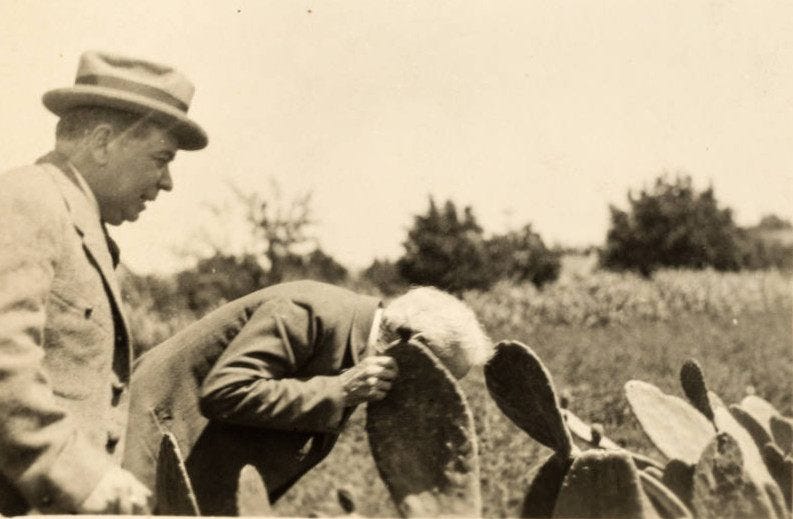
This reversion-back-to-the-wild also rears its head in our trusty domestic crops. Zuchinis (courgettes) can, under certain conditions, produce lethal amounts of a toxin called cucurbitacins. Most people know to cut out the green parts of a potato - they contain toxins called solanines and chaconine.
Whilst we may fear these poisonous events, I think they also serve as a useful reminder that nature can never fully be tamed.
So who are we to retread in the great Burbank’s footsteps?
I have reason to believe that we can safely avoid spontaneous prickle regeneration if we follow certain conditions.
Species selection
We know that Burbank mostly chose O. ficus-indica and O. robusta, so let’s tread a different genetic path. My research has unearthed a few:
Opuntia ficus-indica var. “Suluhna”
Opuntia stricta var. “Spineless”
Opuntia cacanapa var “Ellisiana”
“Suluhna” is an interesting Indian fig cactus cultivar that is grown in Tigray, Ethiopia as a food crop. Its fruit was found to be free from glochids, but I don’t know if the rest of the plant follows suit.
“Stricta” is a spineless form of the Shell Mound Pricklypear, but still bears glochids all over.
“Ellisiana” is a spineless and very rarely glochid bearing form of the Texas Blue Pricklypear. Unfortunately, the fruits have spines.
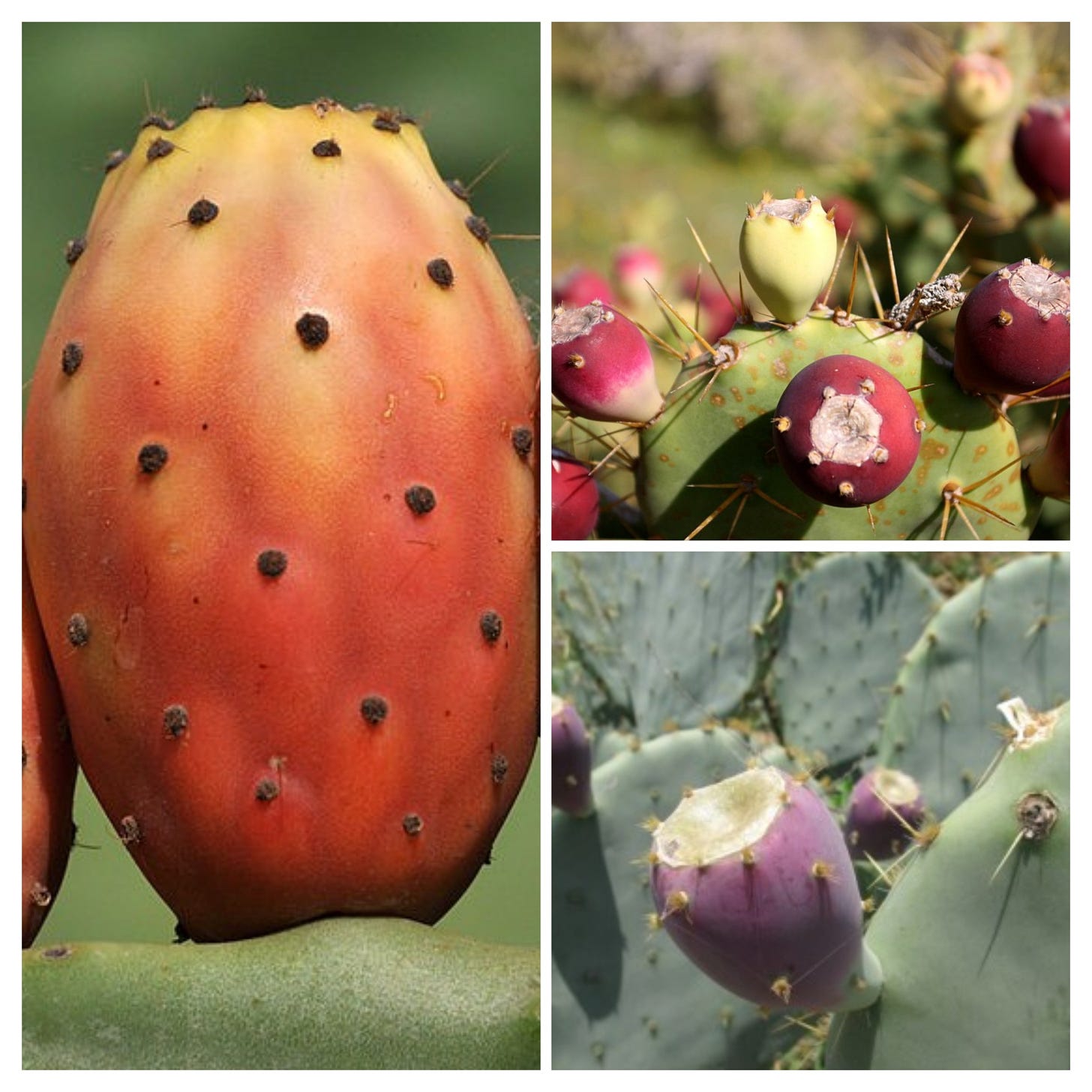
Domestication
The problem with planting out a whole stand of the listed cultivars is that they probably won’t sire spineless and glochid-less offspring. This is a really important step. The last thing we want is to produce a swarm of prickly cactus. These varieties should be viewed as muzzled wild plants rather than domesticated true friends.
My suggestion is to cross Ellisiana with Suluhna, producing O. ficus-indica x O. cacanapa. The resulting hybrids should exhibit high vigour, morphological variety and almost certainly spines and glochids. We stand a chance of producing a child with no prickliness anywhere as Ellisiana has no prickles on it’s non-fruiting parts, and Suluhna has no prickles on its fruit. From here, we keep selecting those which have the least amount of spines and glochids. I would bias towards less glochids as soon as possible to reduce any hazards, with a second but strong preference towards less spines.
Unfortunately for us, O. ficus-indica can take up to a decade to bear fruit. I can’t find any literature on how long O. cacanapa takes to fruit. I hope prospective adopters of this project are patient.
If the breeder wants bonus points, the final spineless and glochidless form can be trialled in extreme heat and drought (which has shown to cause spines to spontaneously re-emerge), from which the specimens with the smallest prickle formation can be further selected.
I would also suggest that the prospective breeder be someone located in an “edge” region - somewhere that Opuntia is not completely comfortable with - to keep up that selection pressure towards higher rainfall regions. I suggest this because it will reduce the chance of any wild escapes (bird eats fruit, poops in nearby region, resultant prickly swarm hellscape).
Along the way you’ll likely be stymied by high percentages of sterile offspring and will likely find that the prickly varieties are hardier to heat and drought.
This is quite a fearsome list to domesticate away, but please don’t let it throw you off the scent. The end goal is a relatively tame plant that has no prickles at all, and whose descendants will have no prickles too.
Tools to help with this might include grafting seedling cactus pads to the mature, prickle-free parents and allowing the graft to bear fruit, hoping that some thorn free genetic material hitches a ride. This is the very same regraft cycle (mentor grafting) that we have talked about in the Franken-plant series.
To describe it briefly, we graft a promising prickle free hybrid descendent onto the original parent (“Ellisiana” or “Suluhna”), wait for the graft to bear fruit and plant the seed and repeat the cycle. The hope (and there is some scientific evidence for this) is that some of the prickle-free parent genetic material migrates into the seeds of the next maturing fruit, from which we then grow another descendent and then graft back onto the parent, concentrating more and more thorn-free genes into the child whilst keeping the vigour of the newly expanded hybrid gene pool.
Like Burbank, I really think a reliably prickle-free Opuntia domestica will unlock the potential of a lot of arid land - something which we desperately need.
Final Thoughts
I decided to insert references (apart from a few embedded ones) at the end of the article rather than my usual link shotgun technique.
You might be aware that various forms of Opuntia are banned due to their “invasive” behaviour in various countries, with Australia perhaps being the most famous example. I have mixed feelings about this, but all I’ll say that there’s a ecological niche for every plant, and extra food crops is never a bad idea in my book.
Until next time.
References
Stress induced reversion of O. ficus-indicia from smoothness to spines
Burbank’s story of breeding spinless O. ficus-indica
A good description of O. cacanapa var Ellisiana
The use of the O. ficus-indica var. Suluhna fruit in Ethiopia as a food crop
High degrees of sterility amongst Opuntia hybrid seedlings
Invasiveness of Opuntia
Some thornless mutations not inherited by offspring
Chromosome count of many Opuntiodeae
The role of glochids as dew harvesters
Growing cactus in the UK, outdoors!
The ever useful Wikipedia entry on Opuntia
Chromosome study of O. ficus-indica local farmer cultivars in Tigray, Ethiopia
My Franken-plant series




If you are trying to eliminate a complex trait then random mutagenesis seems like the best approach. Generating delicate functional structures like glochids likely relies on a complex network of genes. The only downside of this approach is that it often damages vital parts of the plant's genome at the same time. And some traits are generated by parallel networks of genes with many redundant elements, so it isnt as easy as knocking out a single essential component. Opuntia are interesting from a genetic perspective since many "species" are in fact hybrid clones that vegetatively reproduce most of the time. Their ploidy levels are all over the place (which is great in a way since cross fertility seems to happen more often than not).
I'm not sure we could build up useful stands of Opuntia in Australia now if we tried. The cactoblastis moth we introduced has become a permanent feature on the landscape and once a decent population accumulates the insect arrives to hollow it out again. It is weird how culture lags behind nature in this regard. Opuntia and some other cacti are still banned like crazy as a result of the trauma we experienced of having half our state covered in prickly pears a century ago (which itself was a result of stunning abuse of the land through tree clearing and overgrazing).